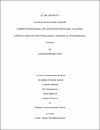Symbiotic dinoflagellates associated with corals in Qatar: characterization and physiological response to environmental change
الملخص
Studying coral reefs’ responses to environmental and anthropogenic stressors is crucial to
ensure the development of appropriate conservation and restoration programs, especially
in areas such as the Arabian Gulf where they are subjected to extreme seawater
temperature stress and experiencing consistent losses in coverage and distribution. Coral
bleaching events witnessed during the last decades in the Arabian Gulf are believed to be
the result of the effect of heat events occurring more frequently in the region as a result of
the global ocean warming. When corals are under thermal stress, their symbiotic
zooxanthellae are affected, and their photosynthetic activity decreases until the stress
disappears or until the zooxanthellae are expelled from the coral. To study the response
of thermal stress on the zooxanthellae associated with the coral host, I exposed three
ecologically important coral species from Qatar, Porites lutea, Dipsastraea pallida, and
Acropora downingi, to three levels of temperature in laboratory aquaria. The three chose
species are known to have differential responses to heat events. Response parameters
were assessed during and after the experiment using fluorescence technique (Pulse
Amplitude Modulation – PAM fluorometry and flow cytometry) to evaluate the coral
health by measuring the photosynthetic activity of Symbiodinium zooxanthellae. Samples
of the three coral species were collected from an offshore reef of Qatar (Um Al-Arshan)
iv
and used to test the effects of different levels of temperature under controlled artificial
conditions. Our results suggested that high levels of temperature 35°C affect consistently
the photosynthetic activity of zooxanthellae within coral tissue of the three species.
Acropora downingi was the most sensitive species to the thermal stress. Indeed the
measured photosynthetic activity in the 35°C treatment was reduced after 17 days, the
coral host bleached after 21 days, and all the colonies died after 24 days. The
photosynthetic activity of Dipsastraea pallida was overall lower than the other studied
species. At 35°C, it started to decrease after 17 days, but D. pallida showed the less
decrease in photosynthetic activity throughout the experiment. Finally, Porites lutea
showed the highest decrease in photosynthetic activity at 35°C. No decrease in
photosynthetic activity was detected at 30°C for the three species. The enumeration and
physiological characterization of zooxanthellae extracted from the corals subjected to
three different temperature treatment (25ºC, 30ºC and 35ºC) were conducted using both
flow cytometry and investigation under microscope. Results showed a consistent
reduction of the ratio healthy/unhealthy cells among all three considered species when
temperature was increased.
DOI/handle
http://hdl.handle.net/10576/6356المجموعات
- العلوم البيولوجية والبيئية [111 items ]


